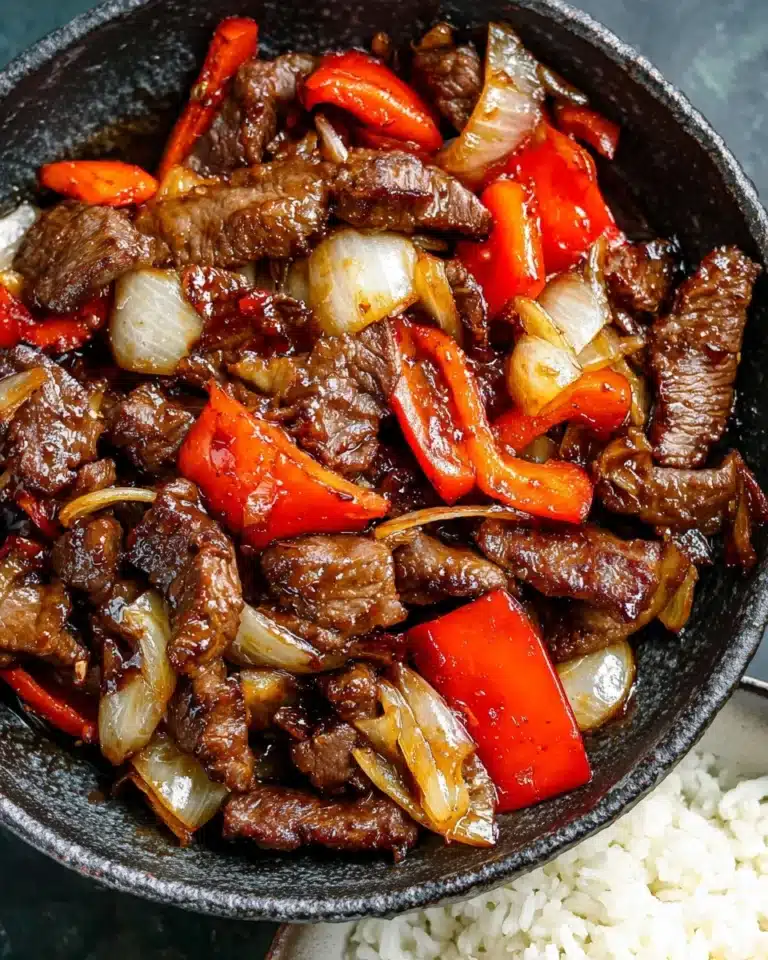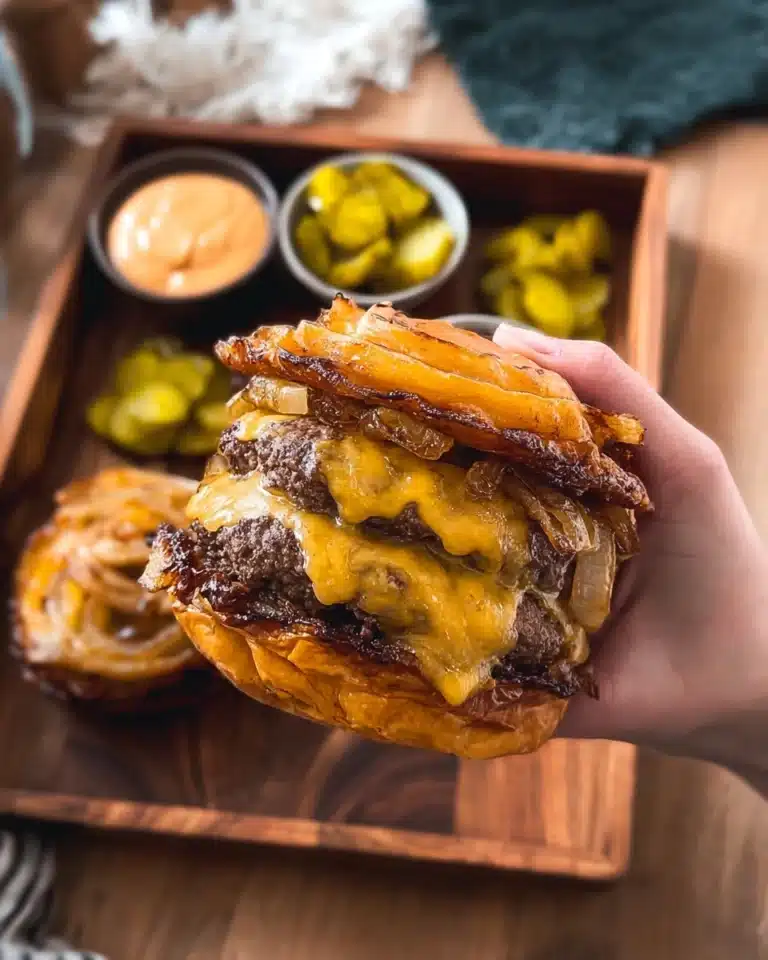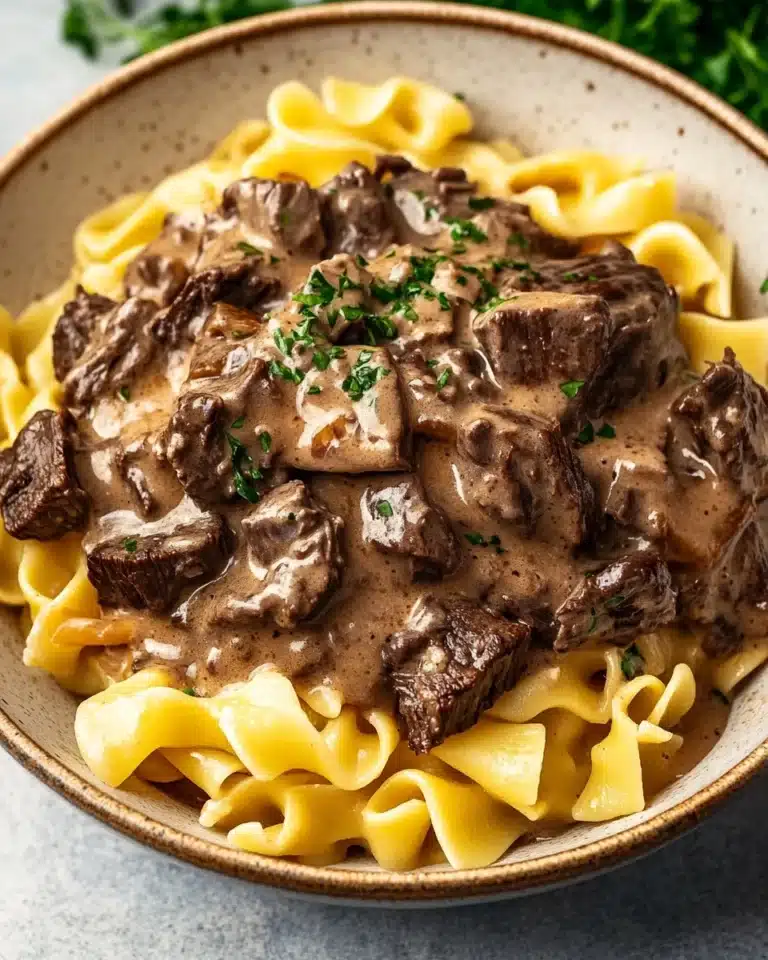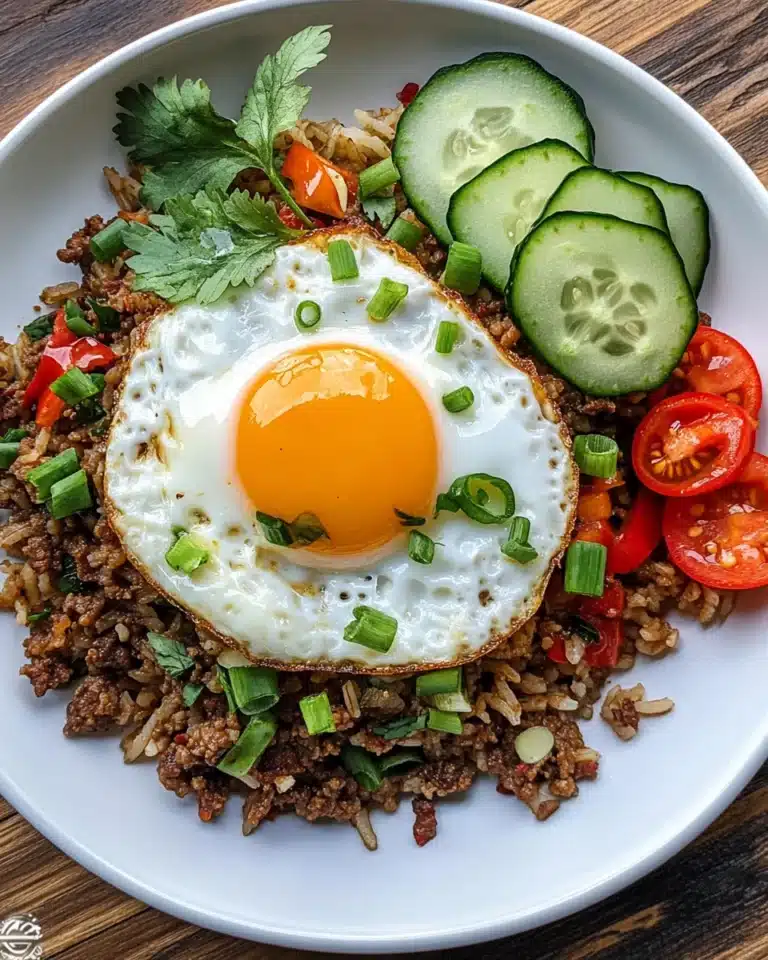If you’re searching for a vibrant, flavor-packed meal that’s as fun to assemble as it is to devour, look no further than the Korean BBQ Beef Rice Stack. This irresistible dish layers tender, marinated bulgogi beef over fluffy rice with a cascade of fresh veggies and drizzled sauces, resulting in an eye-catching tower of tastes and textures. The Korean BBQ Beef Rice Stack promises the ultimate banquet in every bite: deep umami richness from the beef, balanced with crisp produce and a gentle fiery kick from traditional Korean condiments. Whether you’re hosting a dinner party or simply shaking up your weeknight routine, this showstopper is sure to become a new favorite at your table.
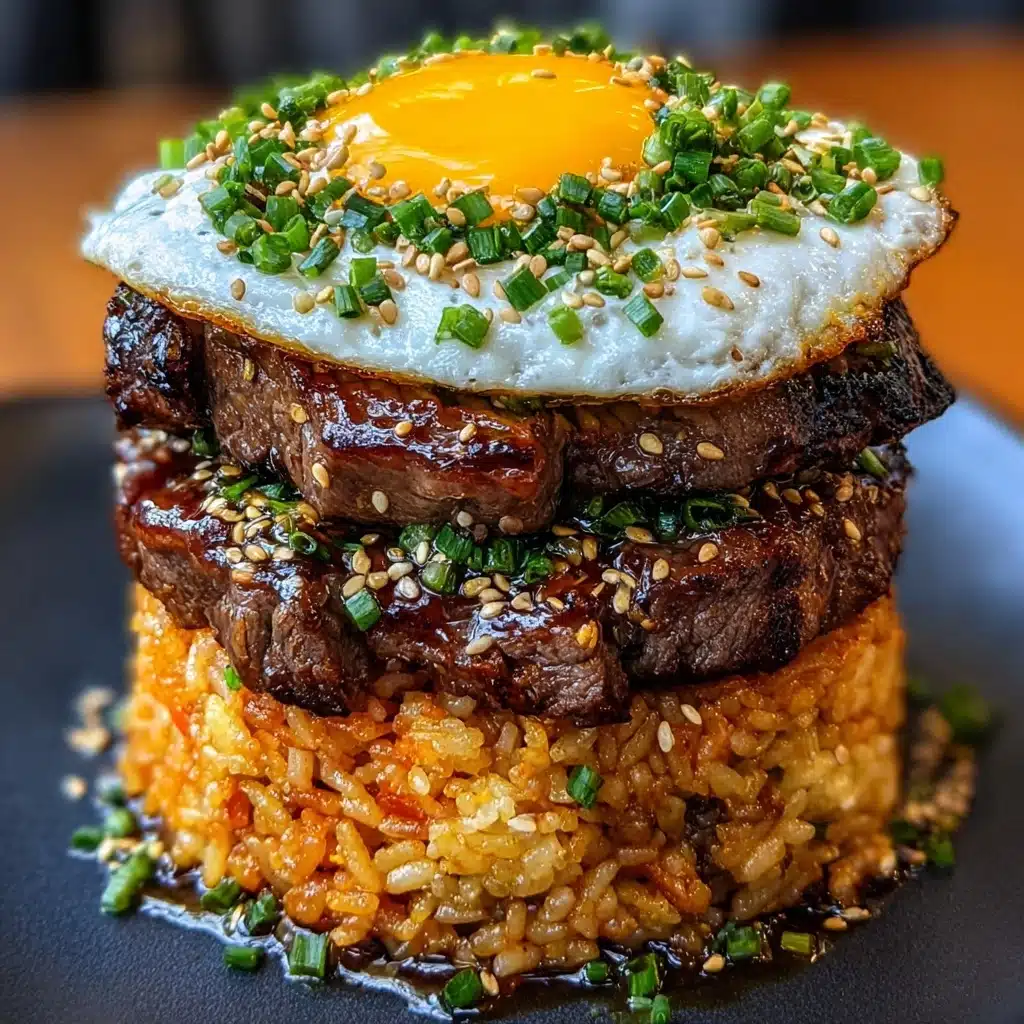
Ingredients You’ll Need
While the component list for your Korean BBQ Beef Rice Stack may look detailed, every ingredient pulls its weight—adding color, punch, or a crave-worthy texture that makes this dish unforgettable. Sourcing the freshest possible items will turn a simple bowl of rice into something truly spectacular.
- Beef (ribeye or sirloin): Thinly sliced, these cuts absorb the marinade beautifully and stay tender after a quick cook.
- Soy sauce: Lends savory, salty depth and ties all the flavors together.
- Sesame oil: Adds a signature nutty aroma that screams “Korean BBQ.”
- Garlic and ginger: Minced or grated, these fresh aromatics infuse the beef with warmth and complexity.
- Sugar: Balances the salty and savory notes, while caramelizing slightly for that traditional bulgogi flavor.
- Short-grain rice: The classic base; sticky enough to hold your stack, fluffy enough to soak up every drop of sauce.
- Cucumbers: Thinly sliced for cool, clean crunch.
- Carrots: Julienned—they give color and a gentle sweetness.
- Leafy greens (lettuce or spinach): Adds freshness and an earthy undertone.
- Mushrooms (shiitake or button): Bring a savory umami punch that harmonizes with the beef.
- Gochujang (Korean chili paste): This sweet-spicy sauce is a non-negotiable for that signature Korean flavor.
- Toasted sesame seeds: Sprinkle on top for texture and visual flair.
- Eggs (optional): Fry an egg for a silky, rich finish that elevates your stack.
- Green onions: Thinly sliced—the perfect pop of color and freshness.
How to Make Korean BBQ Beef Rice Stack
Step 1: Marinate the Beef
Begin by combining soy sauce, sesame oil, sugar, minced garlic, and grated ginger in a mixing bowl. Add thinly sliced ribeye or sirloin to the bowl and toss to coat every piece evenly. For the best results, let the beef marinate for at least 30 minutes—but if you have time, tuck it in the fridge overnight for the most incredible flavor infusion. The marinade not only builds complexity but also tenderizes the meat, setting the stage for a stellar Korean BBQ Beef Rice Stack.
Step 2: Prepare the Rice
Rinse your short-grain rice under cold water until the water runs clear—this little step removes excess starch and gives your rice a perfectly chewy texture. Cook according to your rice cooker or stovetop method, aiming for plump, sticky grains that will form the structural base of your stack. Fluffy yet sturdy rice is the secret weapon that holds the whole Korean BBQ Beef Rice Stack together.
Step 3: Prep the Vegetables and Toppings
While the rice and beef are doing their thing, thinly slice your cucumbers and carrots, tear leafy greens, and optionally sauté mushrooms for a bit of extra depth. Chop green onions and set aside toasted sesame seeds for garnishing. If you want an extra decadent touch, fry an egg to top your stack just before serving. These crisp, fresh, and flavorful veggies turn your Korean BBQ Beef Rice Stack into a rainbow of taste and nutrition.
Step 4: Cook the Marinated Beef
Fire up a hot skillet or grill pan, and cook your marinated beef in batches so it caramelizes rather than steams. Each slice only takes a minute or two—don’t overcrowd the pan! As the beef sizzles, you’ll know the fragrance alone is setting this Korean BBQ Beef Rice Stack apart. Once cooked, set the beef aside and get ready to build your stacks.
Step 5: Layer the Korean BBQ Beef Rice Stack
In your favorite bowl or plate, lay down a bed of warm rice, followed by a layer of luscious beef. Scatter the fresh veggies and mushrooms on top, then drizzle generously with gochujang and a touch more sesame oil. If you’re adding an egg, crown your stack now. Sprinkle everything with green onions and toasted sesame seeds for a finishing touch that looks as good as it tastes. The key is to layer thoughtfully, ensuring each bite delivers a harmonious mix of flavors and textures.
How to Serve Korean BBQ Beef Rice Stack
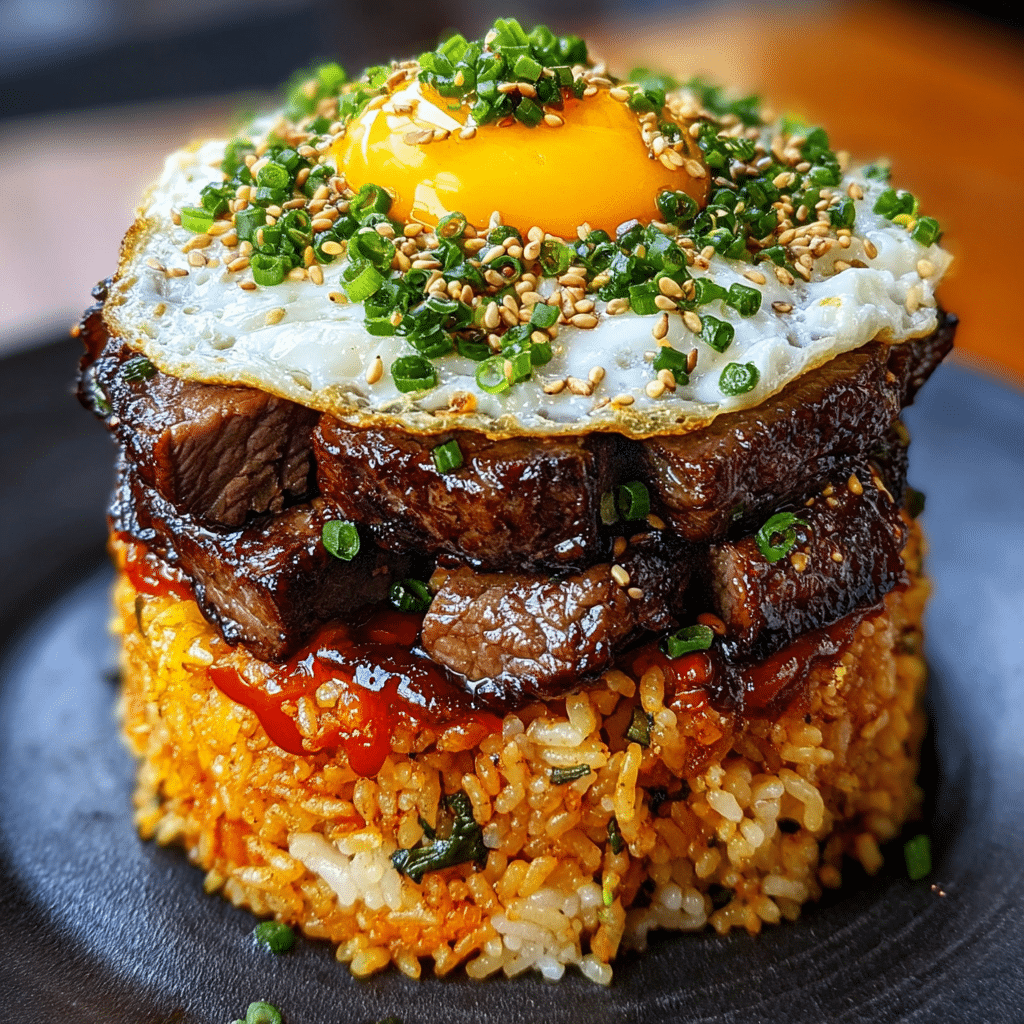
Garnishes
A gorgeous Korean BBQ Beef Rice Stack deserves a finishing flourish! Try a liberal sprinkle of toasted sesame seeds and sliced green onions for crunch and color, or lay on a few microgreens for an elevated look. The classic fried egg (sunny side up, naturally) adds a creamy, rich topper as the yolk flows over the stack. For some added brightness, a handful of shredded nori (dried seaweed) or a quick pickle of radish is irresistible.
Side Dishes
Turn your Korean BBQ Beef Rice Stack into a true Korean feast by pairing it with a spread of classic banchan. Kimchi’s tang and heat cut through the rich beef, while quick-pickled cucumbers or radishes offer a fresh, palate-cleansing crunch. For something extra, a cold seaweed salad or spicy mung bean sprouts on the side round out a meal that sings with balanced flavor and texture.
Creative Ways to Present
Elevate your presentation by using individual glass jars or ring molds to shape each Korean BBQ Beef Rice Stack before inverting onto plates—guaranteed wow factor! For parties, serve stack components deconstructed and let guests create their customized towers at the table. Miniature stacks assembled on appetizer spoons make irresistible starters for a dinner gathering. However you choose, a playful presentation turns this meal into an unforgettable experience.
Make Ahead and Storage
Storing Leftovers
If you’ve made more Korean BBQ Beef Rice Stack than you can finish (it happens!), simply let the components cool before storing them. Divide rice, beef, and toppings into separate containers to keep everything fresh and prevent sogginess. Properly sealed and chilled, leftovers will stay delicious for up to 4 days in the fridge—just layer up whenever hunger strikes.
Freezing
The beef and rice freeze best when stored separately; place them in airtight containers or freezer bags, label with the date, and freeze for up to 2 months. Vegetables are best enjoyed fresh, so only freeze those if you don’t mind a loss in crispness. When ready to serve, thaw overnight in the fridge for the best texture before reheating and stacking.
Reheating
To reheat a Korean BBQ Beef Rice Stack, pop the rice and beef into a microwave-safe bowl, cover with a damp paper towel, and heat in short bursts until piping hot. Alternatively, warm them on the stovetop with a splash of broth or water to keep things moist. Add fresh veggies and any sauces after heating for the crunchiest, most vibrant flavor.
FAQs
Can I make the Korean BBQ Beef Rice Stack vegetarian?
Absolutely! Swap out the beef for marinated tofu, tempeh, or even sliced portobello mushrooms to capture all that delicious flavor without the meat. Adjust the seasonings as needed, and enjoy a totally satisfying, plant-based stack.
Is it possible to prepare the rice in advance?
Yes, you can cook and cool your rice up to two days before assembling your Korean BBQ Beef Rice Stack. Store it in a sealed container in the fridge; just reheat gently before serving to maintain that perfect sticky texture.
What are some good gluten-free alternatives for this recipe?
Simply use tamari or coconut aminos in place of standard soy sauce, and double-check that your gochujang brand is gluten-free. The rest of the components are naturally gluten-free, making this an easy adaptation.
Can I use a different protein besides beef?
Of course! Thinly sliced chicken, pork, or even shrimp work well—just adjust cooking times as needed. The twist will still taste fabulous layered in your Korean BBQ Beef Rice Stack.
How spicy is the Korean BBQ Beef Rice Stack?
You control the heat! Gochujang can range from mild to fiery, so start small and add to taste. If you’re spice-shy, a mild version or a drizzle of sesame-soy sauce will keep things flavorful and accessible for everyone.
Final Thoughts
Once you try building (and then devouring) your own Korean BBQ Beef Rice Stack, it’s bound to land on your “repeat worthy” list. The magic lies in its layers—each bite is a new adventure of flavors and textures. So gather your favorite ingredients, bring some friends to the table, and celebrate the fun and flavor of this irresistible stack!
Print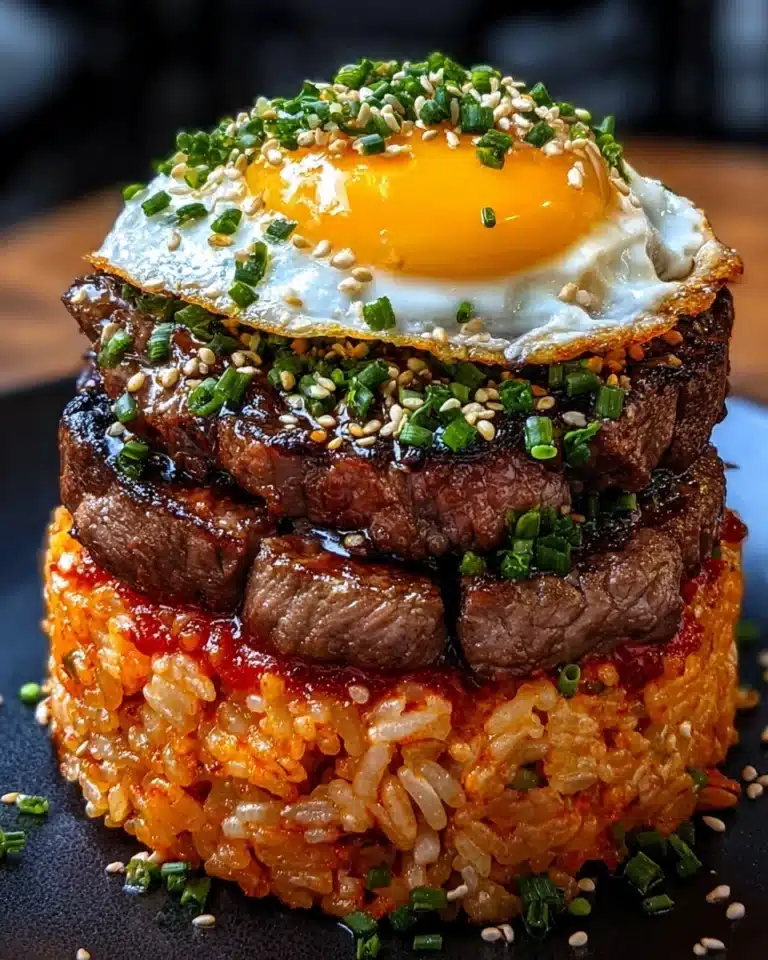
Korean BBQ Beef Rice Stack Recipe
The Korean BBQ Beef Rice Stack is a visually stunning, flavor-packed dish that layers savory marinated bulgogi beef with fluffy short-grain rice and a vibrant selection of fresh vegetables. Drizzled with gochujang sauce and topped with a fried egg, this stack embodies the harmony of Korean cuisine—rich, spicy, slightly sweet, and deeply satisfying. Perfect for a show-stopping main course at gatherings, this customizable meal is as versatile as it is delicious.
- Total Time: 50 minutes (excluding marinating)
- Yield: 4 servings
Ingredients
For the Marinated Beef (Bulgogi)
- 1 lb (450g) ribeye or sirloin beef, thinly sliced
- 3 tbsp soy sauce
- 2 tbsp sugar
- 1 1/2 tbsp sesame oil
- 3 cloves garlic, minced
- 1 tsp fresh ginger, grated
- 1/4 tsp black pepper
For the Rice
- 2 cups short-grain rice (or medium-grain rice or cauliflower rice), rinsed
- 2 1/2 cups water
Vegetables & Toppings
- 1/2 cup cucumber, thinly sliced
- 1/2 cup carrots, julienned
- 1/2 cup leafy greens (lettuce or spinach)
- 1/2 cup mushrooms, thinly sliced (optional)
- 1/4 cup scallions, sliced
- 1/4 cup bell pepper, julienned
- 4 eggs (optional, for topping)
Sauces & Garnish
- 3 tbsp gochujang (Korean red chili paste)
- 1 tbsp sesame oil (for drizzling)
- 2 tsp toasted sesame seeds
- 2 tbsp soy sauce (for additional dressing or to taste)
Suggested Accompaniments (Optional)
- Kimchi
- Pickled radish
- Seasoned spinach
- Fresh herbs (cilantro, green onions)
- Crispy fried garlic
Instructions
- Marinate the Beef: In a bowl, combine soy sauce, sugar, sesame oil, minced garlic, grated ginger, and black pepper. Add the thinly sliced beef, ensuring each piece is coated. Cover and refrigerate for at least 30 minutes, preferably 2-4 hours or overnight for best results.
- Prepare the Rice: Rinse the short-grain rice under cold water until the water runs clear. Soak for 30 minutes, then drain. Cook using a rice cooker or on the stovetop with 2.5 cups of water. (If using cauliflower rice, pulse cauliflower florets in a food processor and sauté with a bit of oil until tender.)
- Prepare the Vegetables: While the rice and beef marinate, prep the vegetables—thinly slice the cucumber and mushrooms, julienne the carrots and bell pepper, wash the greens, and slice the scallions.
- Cook the Beef: Heat a grill pan or skillet over medium-high heat. Add the marinated beef in a single layer, working in batches if necessary. Cook for 2-4 minutes per side or until the beef is caramelized and cooked through. Remove from heat and set aside.
- Fry the Eggs (Optional): In a separate skillet, fry the eggs sunny-side up to keep the yolk runny. These will crown the rice stacks for added richness.
- Assemble the Stacks: Start with a base layer of cooked rice on each plate (about 1 cup per serving). Top with half a cup of cooked bulgogi beef. Add a layer of assorted vegetables (a quarter cup each of cucumber, carrots, greens, mushrooms, and peppers). Drizzle gochujang and sesame oil over the stack. Place a fried egg on top, garnish with scallions and toasted sesame seeds.
- Serve and Enjoy: Present the rice stacks with optional banchan like kimchi and pickled radish. Serve immediately so everyone can dig in while the ingredients are warm and fresh.
Notes
- For the most tender beef, slice the meat very thinly against the grain.
- Vegetables can be swapped based on season or preference; try adding radishes, bean sprouts, or avocado.
- Make vegetarian/vegan: Replace beef with marinated tofu or mushrooms and skip the egg, using vegan gochujang if needed.
- Gochujang adds heat—adjust the amount according to spice tolerance.
- To save time, prepare the beef and rice ahead, then assemble just before serving.
- Store leftovers with beef and rice in separate airtight containers for best texture.
- This dish can also be served in bowls instead of stacked for a more casual presentation.
- Prep Time: 25 minutes (plus 2-4 hours marinating time)
- Cook Time: 25 minutes
- Category: Main-course
- Method: Stovetop
- Cuisine: Korean
- Diet: Halal
Nutrition
- Serving Size: 1 rice stack (approx. 1/4 of recipe)
- Calories: 630
- Sugar: 10g
- Sodium: 880mg
- Fat: 19g
- Saturated Fat: 6g
- Unsaturated Fat: 12g
- Trans Fat: 0g
- Carbohydrates: 79g
- Fiber: 3g
- Protein: 34g
- Cholesterol: 210mg



